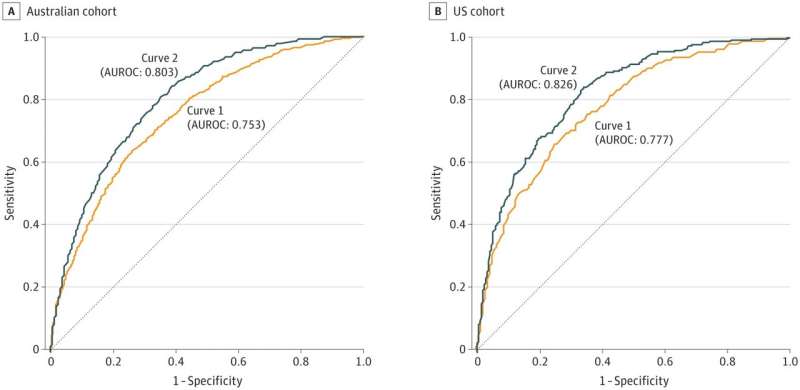This article has been reviewed according to Science X's editorial process and policies. Editors have highlighted the following attributes while ensuring the content's credibility:
fact-checked
peer-reviewed publication
proofread
New study generates predictive model to help identify melanoma patients best eligible for sentinel lymph node biopsy

Clinical eligibility guidelines determine the criteria by which patients are selected for various medical procedures. But strict reliance on established guidelines can overlook patients who might benefit from a procedure, while selecting some who are unlikely to benefit.
In a first-in-kind study of a decision analytical model, researchers at Sutter Health's California Pacific Medical Center (CPMC) and colleagues in Australia developed a patient-centered approach that more accurately identified melanoma patients eligible for sentinel lymph node biopsy (SLNB). Findings of the study were published online today in JAMA Network Open.
"Improved accuracy in predicting SLNB-positivity enhances the cost-effectiveness of selecting patients for SLNB. Beyond SLNB for melanoma, our results may have important implications for how guidelines are developed for selecting patients to undergo other useful and needed medical procedures," says Mohammed Kashani-Sabet, M.D., Medical Director of CPMC's Cancer Center in San Francisco, CA and corresponding author of the study.
SLNB is a reliable staging tool, with SLN status being the most powerful prognostic factor for clinically localized primary melanoma.
Dr. Kashani and colleagues conducted the retrospective cohort study of SLNB-eligible, clinically-localized primary cutaneous patients from melanoma centers in the U.S. and Australia (3,640 Australian and 1,342 U.S. patients). The study also included 2,349 Australian melanoma patients eligible for but who did not undergo SLNB.
Individualized probabilities of SLNB-positivity generated by a patient-centered methodology (PCM) were compared with those generated by conventional multiple logistic regression analysis of 12 prognostic factors. Prognostic accuracy was assessed by the area under each methodology's receiver operating characteristic curve (AUC). Results showed PCM-generated probabilities achieved an AUC of 0.803 to predict SLNB positivity (Australian cohort) and 0.826 (U.S. cohort), higher than corresponding AUCs generated by conventional logistic regression analysis.
The study subsequently assessed the appropriateness of patients selected to undergo SLNB using cost-effectiveness measures, with effectiveness defined as the actual or expected number of positive SLNBs achieved, while cost was defined as the required number of procedures performed to identify those positive SLNBs.
Importantly, the analysis identified a cost-effectiveness dominance range, in which both outcome measures were improved. PCM identified a cost-effectiveness dominance range with cutoffs of SLNB positivity from 8.7% to 23.7%.
Thus, a minimally-acceptable PCM-generated probability of 8.7% would elicit the same number of SLNBs as historically performed, but with a 36.8% improvement compared to the actual experience. In contrast, adopting a 23.7% PCM-generated minimum cutoff probability would result in performing 49.9% fewer SLNBs, but with the same expected number of positive results.
Many melanoma centers recommend patients to undergo SLNB when the positivity rate for the procedure is between 5% and 10%.
"A provocative finding of this study is that adopting the 10% cutoff was within the cost-effectiveness dominance range, while the 5% cutoff was outside this range. This means adopting many SLNB-positive probabilities as a minimally-acceptable patient selection criterion can help identify patients best eligible for SLNB," says Dr. Kashani.
He adds, "Importantly, this approach reflects a conceptual advance beyond a strictly categorical approach (i.e., whether a patient is eligible to undergo a given procedure) to a comparative approach (i.e., which patients are more eligible to undergo that procedure) in contexts where differing degrees of eligibility are both sensible and ascertainable."
The next steps of the research will be to realize the improvements in cost-effectiveness by utilizing this approach prospectively in melanoma patients, and to apply this methodology to the selection of patients for other useful medical procedures such as mammograms and colonoscopies.
More information: James R. Miller et al, Improving Selection for Sentinel Lymph Node Biopsy Among Patients With Melanoma, JAMA Network Open (2023). DOI: 10.1001/jamanetworkopen.2023.6356

















